Power electronic handbook
Подождите немного. Документ загружается.

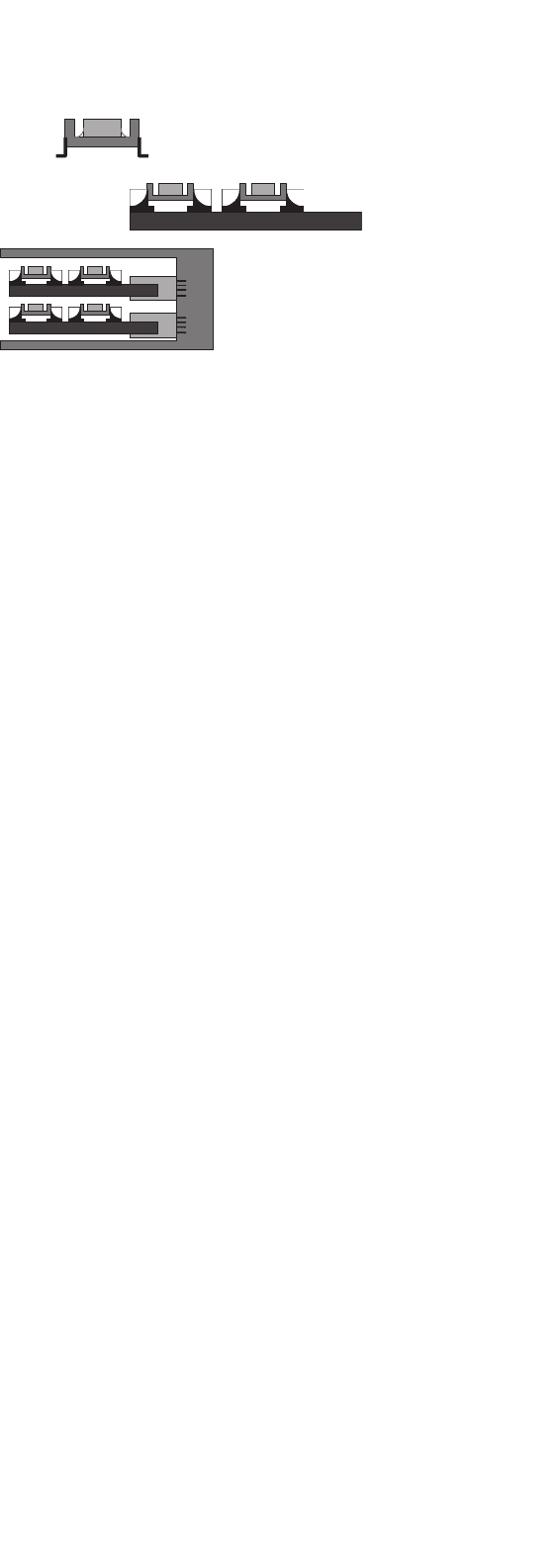
1150 D. C. Hopkins
active or passive, such as ICs or heat sinks. Topologies are
the positioning of the components to provide a function, such
as a buck converter or the thermal structure of silicon sol-
dered on copper clad to ceramic. Controls provide a preferred
set of rules for operation of those components, such as volt-
age regulation or a thermostatically controlled fan. Hence, a
“circuit” design involves electrical and physical design. The
physical design is packaging and can be defined as
“. . . the art (design) of arranging components to provide a
function or characteristic”
Note that packaging is a design function, whereas man-
ufacturing embodies the processes to fabricate the designed
arrangement. Although packaging and manufacturing are
strongly interrelated, they are not synonymous.
The term “physical” should be further defined. The term
“Electrical” identifies the form of energy being processed.
Hence, “physical” represents other forms, such as mechani-
cal, thermal, chemical, photonic, etc. The power electronics
designer is mostly interested in electric, magnetic, mechanical,
and thermal. Discussion will be limited to these four energy
forms.
An integrated design problem example relating the four
energy forms of interest is as follows. A high-frequency mag-
netic core couples the radiated field into a copper conductor
on a printed wiring board (PWB) and causes eddy current
heating, increasing the skin-effect resistance. Higher resistance
loss further increases conductor heating which increases the
mechanical stresses between the conductor and PWB leading
to early failure. Who would notice the problem first? The elec-
trical designer through circuit loss measurements; the thermal
designer through a thermograph of that specific spot, or the
packaging engineer who first notices the conductors are lift-
ing off the board and assumes the conductor adhesion is poor
because of faulty chemistry?
42.4.1 Levels of Packaging
The Levels of Packaging divides a system, top–down, into lower
and lower subassemblies with the boundary drawn between
assembly and subassemblies as shown in Fig. 42.2.
Each level is defined and numbered, bottom–up, in a
micro-to-macro manner. Three traditional levels in electronic
packaging [3] are also applicable to power packaging. Note that
levels are not easily defined. Some packages may be categorized
in either of the two levels depending on the application.
Level-0: Component(s). This is the base level for a component
that a designer can obtain and may be a passive, discrete
semiconductor or integrated circuit, including a “smart
power” circuit. The semiconductors and ICs are typically
Silicon (Si), though there is significant development in SiC
and GaAs for higher operating temperature and speed.
Level-1: Component(s) in Package. This is basic component pack-
aging. Examples include mount-down and lead-attach of a
Level 1: Component(s)
in Package. (Module)
Level 2: Package
on Board
Level 3: Board in
Rack
FIGURE 42.2 Levels of packaging.
component or semiconductor in a discrete package, or mul-
tiple components in a module. Traditional “chip and wire”
hybrid circuits mounted in a housing (often, hermetic) are
Level-1 packages. The package provides a “self contained
environment” that allows the components to be tested,
transported, and used at the next higher level of packaging
while buffering electrical, mechanical, and chemical dis-
continuities from the next level. This package becomes a
subassembly to the next higher level.
Level-2: Package on Board or Board-Level Assembly. These
boards carry mixed-technology components (capacitors,
resistors, inductors, and packaged discretes) that are usu-
ally coated and terminated with a connector. Examples are
printed circuit board (PCB), IMS, and SMT boards. They
differ from Level-1 in the lesser sophistication in fabrica-
tion. The board provides a functional partition and is a
subassembly to the next packaging level.
Level-1.5 (half-level): Chip on Board (COB). This mounts “chip
and wire” semiconductors directly to a PCB or on IMS.
A driver in packaging is to combine levels. An objective
of the road map will be the development of a direction to
combine levels.
Level-3: Board in Rack or Box-Level Assembly. At this level the
rack or case is considered. Each board or module is a sub-
assembly connected to a rack backplane, motherboard, or
free-wired together. An example is the output modules in
a multi-output power supply. The sub-module approach
provides flexibility and fast assembly time.
Definition of levels can continue into Level-4: Rack in
Cabinet and Level-5: Cabinet in Room or Multiple Cabinet
Level. Note that all the technical issues of packaging, embod-
ied in passing energy across an interface or along a pathway,
are the same for all levels of packaging.
42.4.2 Technologies
The delivery form, i.e. mechanical support structure for
integrating functions, divides the technologies. The simplest
delivery form is a mono-material approach, such as a sili-
con integrated circuit. A thick-film hybrid uses ceramic-glass
structures to create functions. A glass-epoxy board (FR-4)

42 Packaging and Smart Power Systems 1151
allows the attachment of discrete components to “integrate
functions.” Functions are not restricted to electrical, but may
include magnetic, mechanical, and thermal.
The delivery form is important since the size of the mounted
components greatly limits the choices in technologies. The
greater the mass of the components, the more mechanically
robust the technology needs to be. The technologies reviewed
below belong to packaging Level-0 through Level-2 and, gen-
erally, sequentially range from fully imbedded components
as in silicon ICs to modestly robust for surface mounted
components, to very robust for clamped, screwed, and axi-
ally leaded. The transition from PTH to SMT occurs within
FR-4 and partly explains the greater acceptance of this versatile
technology.
Semiconductor Power Integrated Circuits – This is considerably dif-
ferent from the remaining packaging technologies in which
it approaches a “mono-material system.” Multiple func-
tions can be produced in one material, usually silicon. This
is expanded in the following section.
Thick Film on Ceramic (TFC) – Glass-based pastes or inks are
loaded with electrically conductive materials, such as cop-
per, gold, or silver, to form interconnects, loaded with
resistive materials to form components, or used unloaded
as dielectrics. The pastes are screen printed on ceramic and
fired at ∼900
◦
C. Vias are formed as holes in dielectric
layers and discrete components are surface mounted with
solder or adhesives. Only two types of air-fired thick film
are considered here: multilayer thick film (TF-multilayer)
for control circuity and thick thick-film( TTF ) where
silver is printed to form up to 160
µm conductors for
power.
Cu Plated on Ceramic (CuPC) – Patterns are imaged or transferred
to the surface of ceramic. Copper is then plated to a thick-
ness <125
µm (5 mils). Discrete components are attached
or full thick-film processing is placed on the plated cop-
per with screen-printed components imbedded or discrete
components attached.
Comparison of technologies
TFC/IMS-PS CuPC IMS-PM DBC DBA FR-4-PTH MID
Conductor material Ag/Cu Cu Cu Cu Al Cu Al
Thickness (mm) 15 25–125 35–140 100–1000 100–1000 17.5–140 5–15
Line width (mm) 100–150 50–100 75–125 75–125 75–125 75–125 75–225
Line pitch (mm) 250–350 50–100 150–250 150–500 150–500 150–250 150–250
Bond pad pitch (mm) 250–350 200 200 200 200 200 200
Max # layers 5–10 2 2 2 2 36 2
Sheet resistance (m/sq) 3–1.2 0.14–0.69 0.14–0.69 0.034–0.135 0.068–0.270 1.1–0.14 9–3
Dielectric material Glass/ceramic Ceramic Polymer (Coating) (Coating) Epoxy/glass Polymer
Dielectric constant 6–9 9.5 6.4 n–a n–a 4.8
Thickness/layer(mm) 35–50 n–a 75–150 n–a n–a 120
Min. via dia. (mm) 200 50–150 300 n–a n–a 300
Substrate material Al
2
O
3
AlN Al
2
O
3
Al, Cu Al
2
O
3
,Al
2
O
3
, AlN Epoxy Polymer
Thermal (W/m-C) 20–35 20–35 26 26, 150–270 0.17
TCE (ppm/K) 7.1 7.1 23 7.3 7.3 13–18
Glass-epoxy with Surface Mount Pads (FR-4, SMT) – A fiberglass
mesh is impregnated with epoxy and metalized with copper.
Interconnect patterns are etched into the foil. The pat-
terned copper clad mesh can be laminated and vias formed
by drilled and plated holes. Chip components are “surface
mounted” with solder attachment or conductive polymer.
Components can also be imbedded using loaded poly-
mers similar to the TFC process, but with low temperature
curing. (SMT is “surface mount technology.”)
Insulated Metal Substrate – Polymer on Metal (IMS-PM) – A poly-
mer is used to isolate and attach a conductive interconnect
to a metal plate which provides mechanical support. Vias
can be placed between the interconnect and plate, and a
layer of polymer and interconnect can be attached to the
interconnect layer.
Insulated Metal Substrate – Steel Corded (IMS-PS) – A high tem-
perature (HT) glass (∼900
◦
C) coats a steel plate and a
thick-film conductive cermet interconnect is applied upon
the glass. The structure is similar to traditional thick film.
Vias are processed as in multilayer thick film.
Direct Bonded Aluminum (DBA) – Aluminum foil is bonded to,
or cast onto ceramic, patterned, and etched. Low-resolution
patterns can be direct cast. Discrete components are surface
mounted with solder or adhesive. There are no vias. This is
an excellent approach for Al bearing substrate materials.
Direct Bonded Copper (DBC) – Copper foil is applied to ceramic,
bonded at ∼1063
◦
C, and a pattern is etched. Discrete com-
ponents are surface mounted with solder or adhesive. There
are no vias.
Glass-epoxy with Plated through Holes (FR-4, PTH) – Same as
above FR-4 except leaded components are solder attached
with leads placed through holes. (PTH is “plated through
holes.”)
Molded Interconnect Device (MID) – A HT plastic or polymer
structure hosting electrical interconnects is fabricated by
1-shot, 2-shot, or insert molding. The interconnections are
formed by hot-stamping copper foil, imaging and metal

1152 D. C. Hopkins
plating the polymer, or insert molding of structured metal.
The MID lends itself to high volume, 3D, net shape packag-
ing and is extensively overlooked in the power electronics
area (excluding automotive). Components can be surface
mounted or through-hole with moderate to course line
resolution. Only the hot embossing is considered here.
Laminated Bus-bar – A polymer, such as epoxy, glues together
thick conductor bars while providing electrical isolation.
The bars can be free-floating laminated interconnects or,
if sufficiently thick, be the metal carrier. Vias between lay-
ers are metal posts or fasteners placed through drilled or
stamped holes. These are used in high-current systems and
can accommodate very large components. These were not
considered in this development.
42.4.3 Semiconductor Power Integrated Circuits
As noted in the Introduction, the term “smart power” has been
used for several decades to describe the imbedding of control
into power processing systems. One approach integrates con-
trol and power into a monolithic circuit, such as silicon, and
takes on two forms. One is the integration of analog and dig-
ital circuitry with discrete power devices. The second applies
to high-voltage ICs used for power monitoring and fault con-
trol. The term “smart power” has become synonymous with
power integrated circuits (Power ICs) or application-specific
power ICs (Power ASICs). Motorola trademarked the term
“SMARTpower” circa 1980.
A designer typically is a user of power ICs and seldom
influences the chip design. Systems partitioning, as described
throughout this chapter, is not directly applicable. However,
once the chip is available, the designer is armed with a more
functionally integrated component. A background to power
ICs is given below to aid the designer in better understanding
the technology. An excellent reference noting the beginning of
high-voltage ICs is an IEEE Press Book by B. J. Baliga [4].
Power ICs can be divided into four groups resulting from a
matrix of low and high voltage, and low and high current capa-
bilities as identified in Table 42.2. The low-voltage, low-current
ICs are readily available for the control and monitoring of
power processing functions. These smart chips control power
supplies, battery chargers, motor drives, etc. and are often
referred to as “power controllers.” These chips are produced
from standard IC processes and limited to the voltages of the
process. The cost follows typical IC cost structures.
TABLE 42.2 Examples of power ICs (smart power)
Low current High current
Low voltage Power control ICs
PWM controllers
Bipolar drivers
Automotive actuators
High voltage Bridge gate drivers
Gas-display drivers
(limited application)
Low-voltage, low-current ICs can be further subdivided into
“dedicated” and “programmable” chips. In the late 1990s and
early 2000s, the incorporation of imbedded control expanded
the definition of “power controllers.” Sophisticated control
algorithms that were implemented in digital signal processors
(DSPs) were incorporated into programmable power con-
trollers. The role of the power electronics designer further
changed to become adept at high-performance programming.
Low-voltage, high-current power ICs again use standard IC
processes for fabrication. The higher current requirement is
met by creating effectively large device areas that maintain
current densities consistent with process characteristics. In the
1970s and 1980s, bipolar processing was dominant and large
area devices were fabricated. Typically, processes were limited
to 40 V and pushed to 60 V for actuator and transistor driver
applications. As a side note, the most successful power metal-
oxide semiconductor FET (MOSFET) driver in the 1980s used
a commercially available digital “line driver” IC. Driver chips
were later developed with FET processes that paralleled many
low-power FET cells. Again, the required area was determined
by the maximum current density of the allowed process.
Dedicated chips of the 1990s used power MOSFET tech-
nology to create driver and actuator chips. Applications of
the low-voltage, high-current ICs fall mostly in the areas of
power conditioning for photovoltaic systems, actuators for
computer hard drives, actuators and motor drives for auto-
motive and appliance applications, and driver applications in
power semiconductors circuits.
Since mostly all IC technology was created for computer and
telecommunications applications, creation of “higher voltage”
ICs for power was slow to develop. Lack of market size in
power did not support substantial technology development,
but rather incremental product development. However, high-
voltage ICs were developed early on for the gas-tube display
market (circa. 1980s). Other significant developments slowly
occurred mostly in drivers for power-bridge circuits as used in
motor drives and “application specific ICs.”
High-voltage ICs are processed with either dielectric isola-
tion or junction isolation. In the 1980s, dielectric isolation was
used extensively by Dionics Incorporated for display drivers
which had ratings of several hundred volts. Dielectric isolation
utilizes silicon-dioxide wells. Devices, such as bipolar tran-
sistors, are fabricated in the wells, which serve as functional
islands. The devices are then interconnected at the surface.
Limitation of the dielectric isolation process is the higher
cost. However, dielectric isolation does provide for more reli-
able isolation with greater circuit flexibility. Both power rating
and current capacity are low relative to junction isolation
because of the planar nature of the structure and interconnects.
Junction isolation became the preferred method starting in
mid-1990s with the developments from General Electric and
Harris companies followed by power-ASICs from power semi-
conductor manufacturers. The isolation method used multiple
levels of p–n junctions to form wells. A cross section of several
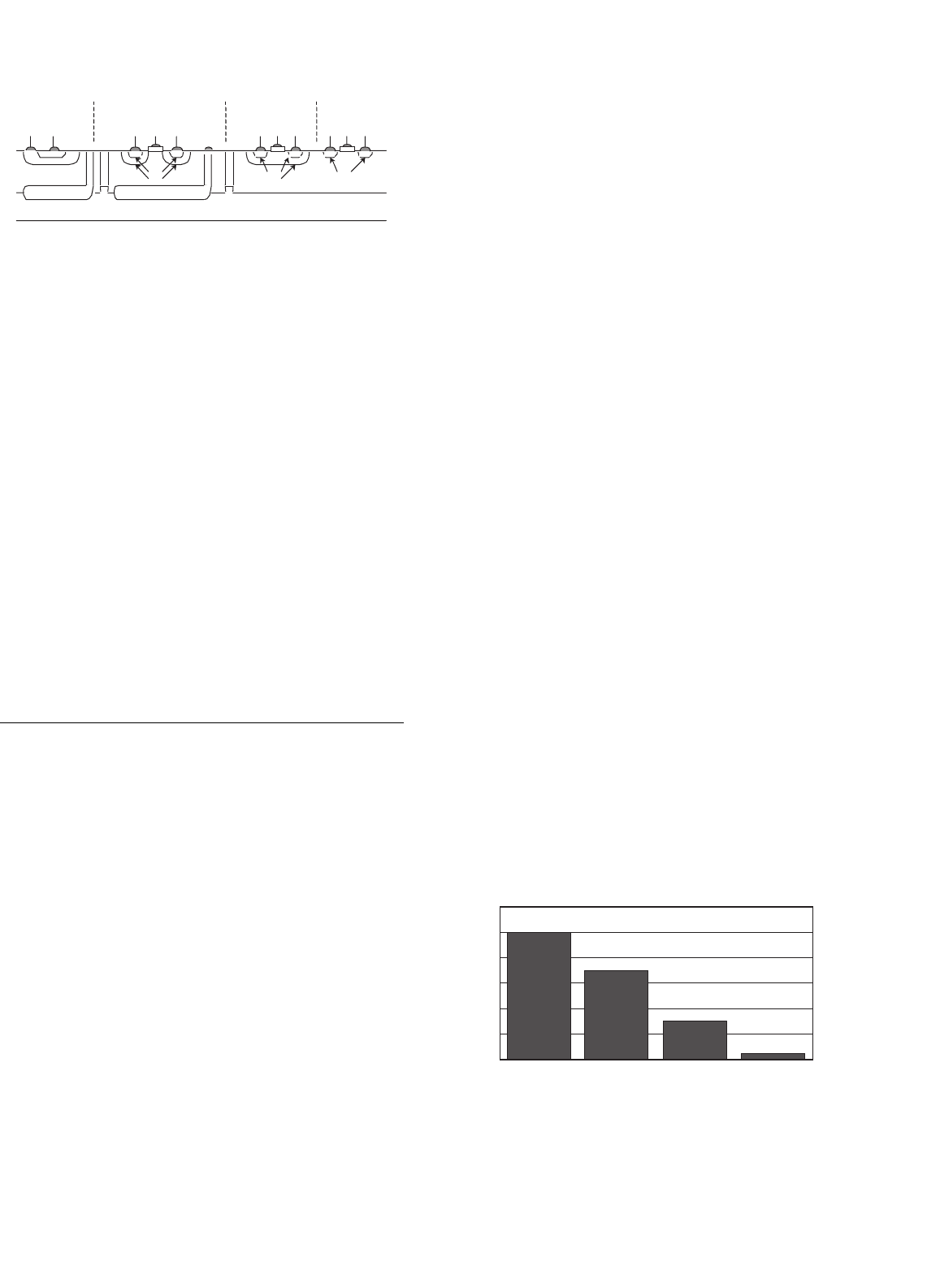
42 Packaging and Smart Power Systems 1153
n
n−
n−
n−
B
p
p
p−
n+
n+
n+
pn+
p−
p+
p
E
D
G
S
BJT NMOS PMOSVDMOS
S
GGSSSS
FIGURE 42.3 Junction isolation used to separate devices or circuits.
basic technologies is shown in Fig. 42.3. Note the p-type
sinkers connecting to the p-material of the substrate to provide
cell isolation. There is also a combination of structures used to
produce a BiCMOS process. The complementary metal-oxide
semiconductor (CMOS) provides the control circuitry while
the bipolar structures provide high current-density transistors
for power processing.
Junction isolation has several limitations, most significant
of which is possible “layer inversion.” Inversion occurs when
the reference substrate, or portions thereof, becomes reversed
biased. Relatively large currents can flow and biasing of four
layer structures can cause latch-up. Manufacturers have paid
significant attention to minimizing this problem. However,
designers must always be cautious that a fault condition or
capacitive current from a high-frequency transient does not
induce an inversion.
42.5 Cost-driven Partitioning [5]
This is the one issue seldom discussed in open literature, yet is
the greatest driver to the selection of circuit design approaches
and determination of partitions. Unfortunately, a designer
often limits cost estimation to only component cost, i.e. the bill
of materials (BOM). The greatest cost is often not the compo-
nent, but the handling, mounting, and testing of a component.
An excellent example is the selection of output filter capacitors
in dc–dc supplies. The use of a multitude of smaller ceramic
chip capacitors, which can be automatically surface mounted,
is often less expensive than larger electrolytic through-hole-
mounted capacitors, and provide much greater reliability over
time. (This applies to larger volume production.)
The use of cost-driven partitioning is also dependent on
the company structure. A vertically structured company with
captive manufacturing has the advantage of increasing volume
by modularizing their circuits to be used across several product
lines. The following procedure uses a Full-cost Model applicable
to both captive and out-sourced manufacturing.
When discussing cost, it is necessary to define centers of cost
for both the product and the business. The terms are defined
as follows.
1. Materials cost represent direct costs of packaging, and
include the minimum packaged component (e.g. sili-
con chip), component packaging materials (e.g. plas-
tic housing on a TO-220), and packaging materials
for manufacture (e.g. solder or adhesives for mount
down). If the manufacturer can mount bare die, then
these quantities are determined separately. If man-
ufacturing is out-sourced, then the “pre-packaged”
component cost accounts for the first two costs and
the manufacturer (or assembler) determines the third
cost. The variation in cost by volume must also be
included. Volume dependency is greatest for cus-
tom products at low volume and lowest for standard
high-volume products. A typical volume cost fac-
tor is 20% decrease in cost per 10-fold increase in
volume.
2. Production cost includes factors for wages and prod-
uct volume, but are independent of material costs,
(which is not often assumed when assessing overhead).
Production cost can be characterized as a function of
technology and quantity. To reflect this into a design
tool, it is necessary to describe production cost as a
function of simple information, such as the number of
surface mount device (SMD) and leaded components,
and square inches of substrate board. Assessment is as
follows for captive production:
1. Determine the total wages, equipment and
facility depreciation, and other facility over-
head.
2. Determine the number of production tech-
nologies in the facility, both in place and
available with minimal extension.
3. Determine technology costs by a ratio of the
above two parameters.
4. Add scaling factors for volume dependency.
In Fig. 42.4, the relative production costs for various
technologies (circa. 1999) are shown for fixed vol-
ume. Note that the chip and wire is less expensive
Leaded-manual
Leaded-auto
Power chip & wire
SMD auto
Assembly technology
0%
20%
40%
60%
80%
100%
120%
Cost/comp.
FIGURE 42.4 Relative production costs.
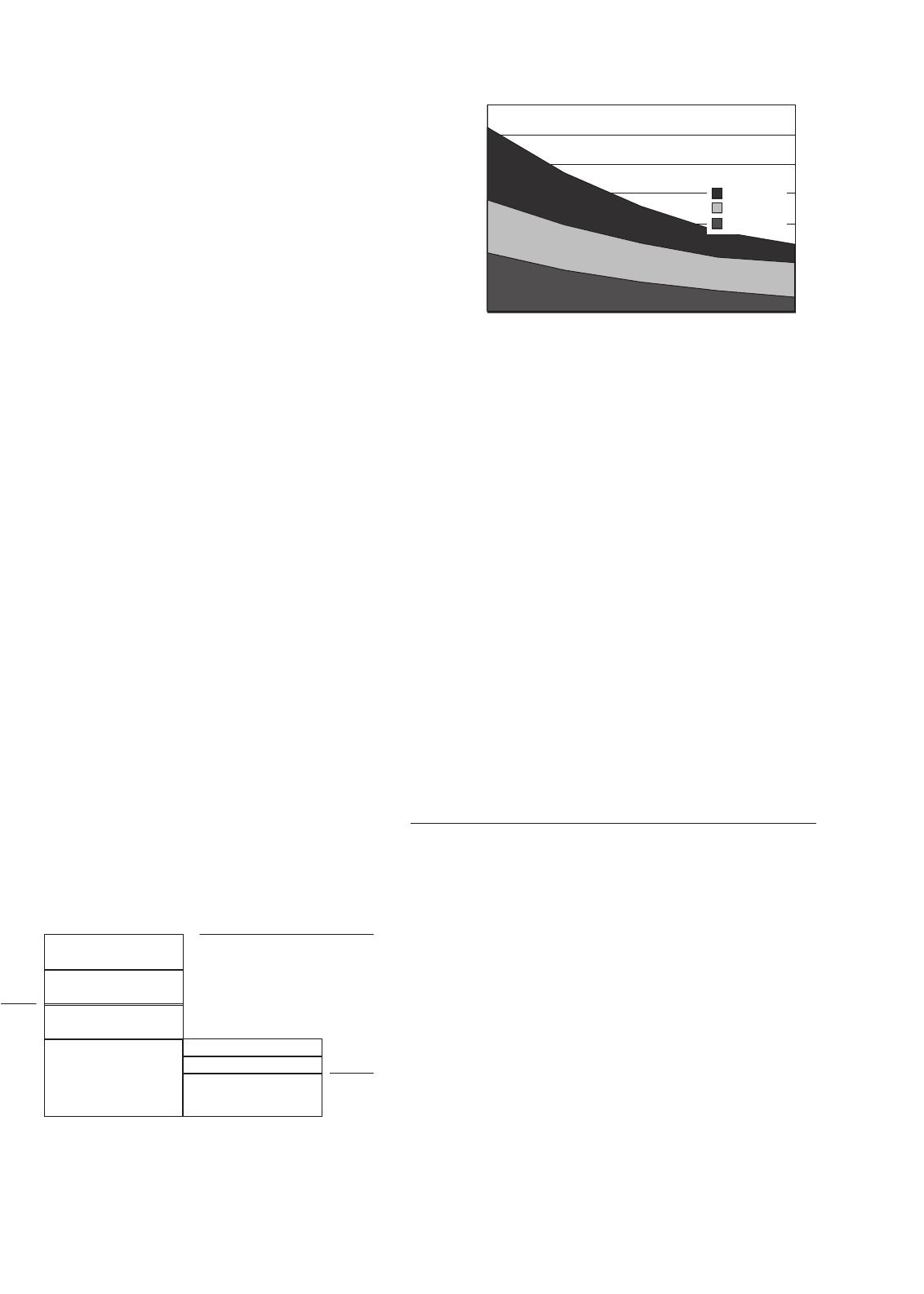
1154 D. C. Hopkins
than handling a leaded component and is typical for
captive facilities. Including the scaling factors in your
calculations to give a volume dependency for a highly
automated production technology. Depreciation is for
production equipment and buildings, whereas other
overhead covers the significant cost involved in pur-
chasing, management, production technology, etc.
3. Partitioning cost is incurred for each technology used.
From the previous technology descriptions, it appears
straightforward to choose “this technology for these
components and those technologies for those com-
ponents” based on technical performance attributes.
However, there is a drawback to this partitioning. Each
partition adds one circuit to be handled through pro-
duction with an additional interconnect and assembly
process. This means the additional incremental costs.
Assembling sub-circuits into a product is similar to
assembling components on boards and is modeled as
cost in wages modified by a different overhead factor.
For chip and wire, costs for protecting (encapsulating)
chips are included if necessary.
4. Full cost combines material costs and production
costs as shown in Fig. 42.5. A minimum-packaged-
component system is chosen to highlight the possibility
of buying non-packaged components, but the model is
valid for any level of packaging. If there is not a captive
circuit fabricator, then the cost is obtained through
competitive quotes or experience with the manufac-
turer. A mixture of in-house and out-sourced costs
can be included in the model.
5. Product business cost, i.e. returns on investment for
development of one product, is an investment in future
payback. The total cash flow from development until
the end of production determines the business costs
for a product.
6. Company business cost, i.e. return on investment for
cross products reflects the cost of sub-optimization
within one single product. The value of reusing the
same packaging technologies, designs (diagrams), and
Other Overhead
Depreciation
Wages
Materials
Comp. packaging
Packaging materials
Minimum packaged
components
OverheadStandard unit cost
Production cost
Packaging material
& prod. cost
FIGURE 42.5 Full-cost model for circuit partitioning.
10k 32k 100k 320k 1M
Products/year
0%
100%
200%
300%
400%
500%
600%
700%
Production Cost
Other OH
Depreciation
Wages
FIGURE 42.6 Cost variation due to volume.
even physical circuits (building blocks) across differ-
ent products should be measured at the company
level. The value of building blocks becomes obvious
through savings in repetitive development costs and
maintenance of function. Development and mainte-
nance costs are saved since the function is devel-
oped only once and unilaterally maintained across all
products.
The impact of volume on building-block cost applied to
three motor drive products is shown in Fig. 42.6. At low
volumes, the main savings are in development and mainte-
nance costs, while at high volumes only savings in full cost
matters. The overall conclusion is that if a partition is neces-
sary to meet requirements, then, the partition must be guided
by strategic choices in order to optimize cost on a company
business level and the relative cost diagrams should be used
only for optimizing within partitions.
42.6 Technology-driven Partitioning
There are several natural aids to partitioning. Ordering com-
mon packaging technologies bytechnical performance, orders
most other attributes. As one moves down the list of tech-
nologies described in Section 42.4.2, one finds increasing
current-carrying capacity, decreasing voltage isolation and
operating frequency, lower thermal performance and density,
less sophisticated processing, and lower cost for lower vol-
umes (except for MID). These monotonic trends allow rich
engineering judgment to effectively group components (step
four in Section 42.3.1) for optimized partitioning.
Partitioning proceeds by following a sequence of first group-
ing and matching the most challenging components with
higher performance technologies. The next challenging com-
ponent grouping is matched with the next technology of lower
performance and typically lower cost. Starting with the highest
performance technology, often lower performing components
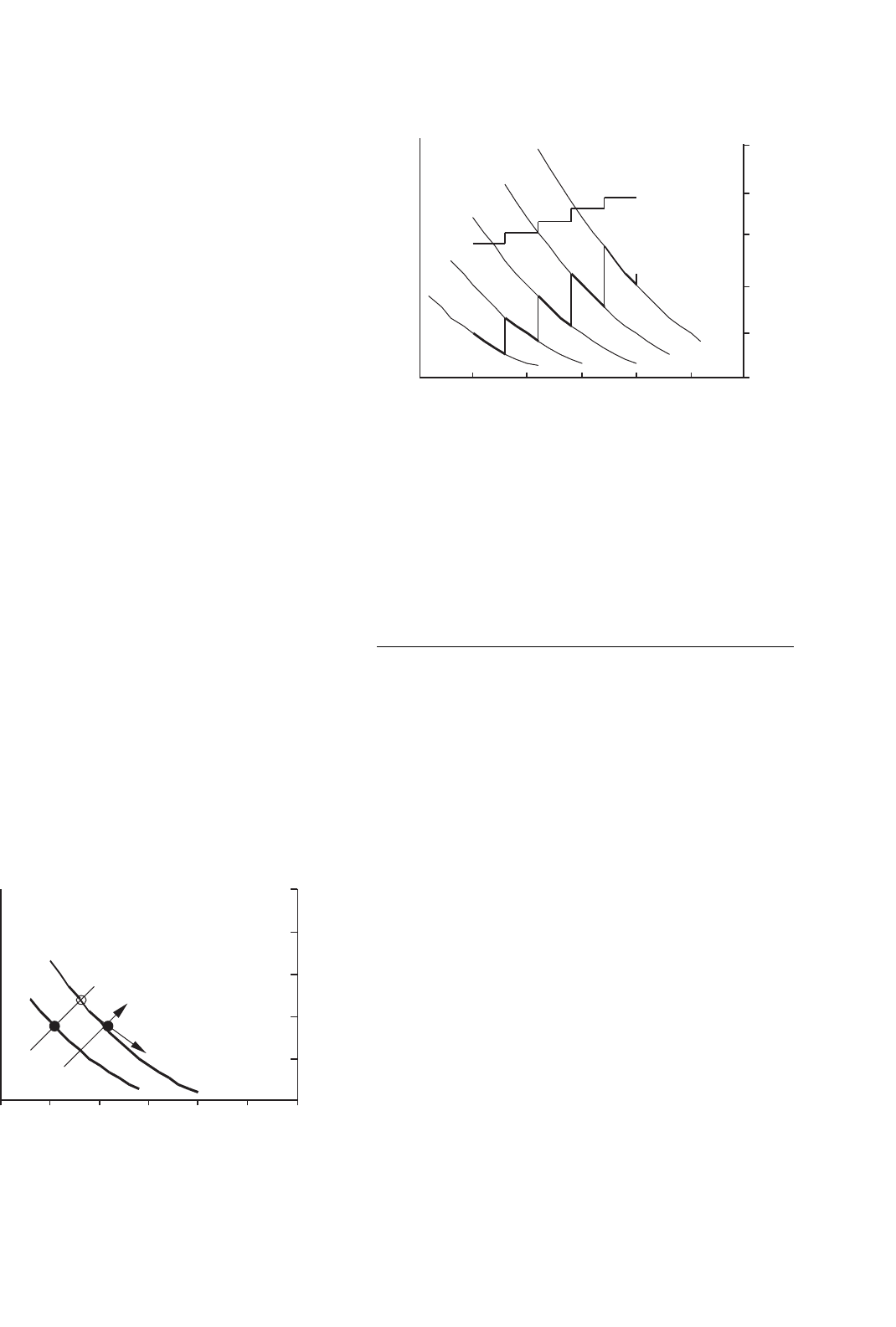
42 Packaging and Smart Power Systems 1155
to be included at little increase in cost. For example, if thick
film ceramic (TFC) is used for chip and wire power die
and current-sense resistors, the inclusion of thick-film control
circuits comes with little added real estate (cost).
Mixing of technologies and technology selection is mis-
understood because a typical perspective is to look at the
“substrate area cost,” i.e. the famous “dollars per square inch”
costing of technologies. This is as limiting as using only a BOM
for cost-driven decisions. A better understanding is required
and is aided by the graphical perspective in Fig. 42.7. View
the curves right to left as density decreases. The falling curves
represent relative Full Cost (Section 42.5) of each technology
as substrate area changes. The starting and ending points are
the practical limits in the use of the technology at certain
densities.
As an example, assume a given circuit is designed with only
one technology, such as thick film (TF), and as dense as pos-
sible. As the board area increases (becoming less dense), the
components grow in size (0603–0805) with larger interconnect
traces; the cost increases, following the curves up and to the
left. A point is reached in an area when a less costly technol-
ogy may be suitable, such as SMT FR-4. This other technology
would decrease the cost for the same area. Hence, not only
do the cost and density decrease (with lower technology), but
the performance also decreases. Within a range near maxi-
mum density, the higher performance TF technology with an
added area is still less costly. This is due to the packaging and
production costs, and is often overlooked by designers who look
at the “cost per square area of boards” without looking at the
full-cost model.
A more generalized set of curves is shown in Fig. 42.8. This
graph, in essence, is created for a specific production facility.
The circuit designer, or design team, would follow the steps to
partitioning, letting the costs of the technologies drive where
partitions are best drawn. Remember that the overall circuit
0 1015202530
Surface Density
Relative Cost
0
0.2
0.4
0.6
0.8
1
Packaging &
Production costs
Packaging Performance-
(electrical, thermal, mechanical)
TF module
& leadframe
FR4
Changing technology
to change density
Functional integration
within technology
110 SMDs
14 leaded
70 SMDs
7 leaded
5
FIGURE 42.7 Cost variation within technologies.
0 1015202530
Surface Densit
y
Relative Cost
0
0.2
0.
4
0.6
0.8
1
DBC
Packaging &
Production Costs
Packaging Performance:
electrical, thermal, mechanical
TF &
Plated Cu
IMS
5
FIGURE 42.8 Generalized relationship of cost and technology.
is composed of electric, magnetic, mechanical, and thermal
circuits.
42.7 Example 2.2 kW Motor Drive
Design
A 2.2 kW motor drive, consisting of electronics, motor and
pump encased in one housing, is used as an example product.
The block diagram of the electronics is shown in Fig. 42.1. For a
(planar) electrical-mesh circuit, the physical assembly pattern
would closely follow the electrical schematic layout and one
packaging technology, such as FR-4, could be used, though not
efficiently. The design would, then follow a single line up and
to the left in Fig. 42.7. Using mixed packaging technologies
provide multiple assembly levels, and the assembly pattern
more closely follows grouping of the physical Delivery Forms
of the components. The steps outlined in Section 42.3.2 are
followed to determine the proper partitioning of the system
to meet the performance requirements and provide maximum
business profit. The steps are summarized as:
1. User requirements,
2. Component characterization,
3. Component grouping,
4. Strategic partitioning with constraints,
5. Optimizing within partitions.
42.7.1 User Requirements (Constraints)
Many user requirements direct the system design as outlined
in Section 42.3.1. However, several requirements place specific
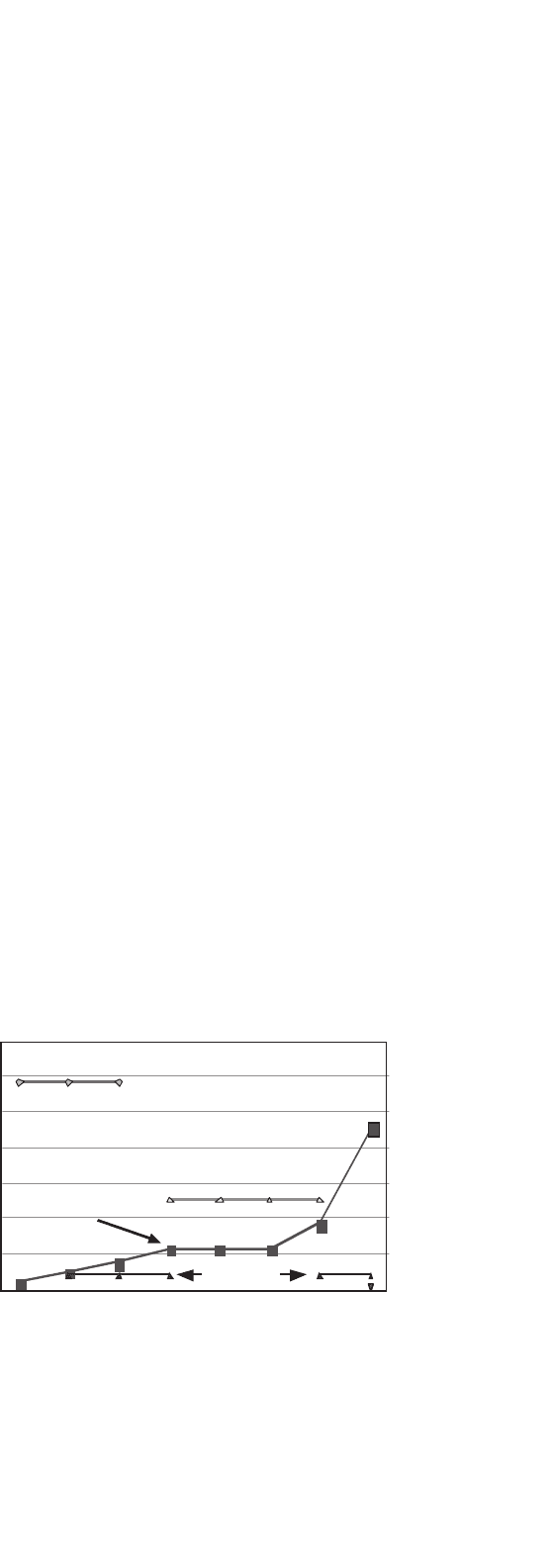
1156 D. C. Hopkins
constraints on the packaging of the 2.2 kW drive as noted
below.
Mechanical: Built in a 65 mm dia. stainless steel tube;
short as possible.
Thermal: Cooling through tube with non-flow of
water at 30
◦
C.
Environment: Potting electronics is disallowed.
Regulatory: UL, CE.
Reliability: 1,000,000 quick start/stop,
30,000 maximum gradient start/stop,
40,000 h lifetime @ 10
◦
C water.
42.7.2 Component Characterization Map
A component characterization map is performed on all the
components to identify the technical and physical attributes
that dominate it, and is illustrated for part of the circuit
as in Table 42.1. In this component characterization map,
components are listed for each electrical functional block.
42.7.3 Component Grouping
An overview of possible groupings into packaging partitions is
obtained by attaching main components and key attributes to
the functional block diagram of Fig. 42.1.
42.7.4 Strategic Partitioning with Constraints
A major constraint is the limited space available (65-mm
diameter). This makes it obvious that some miniaturization
is very valuable, but what should be miniaturized? Packag-
ing cannot miniaturize leaded components. These components
require either through-hole PCB (FR-4, for soldering) or some
form of lead frame (MID for welding). Power die are top can-
didates for miniaturization because the die can be grouped
into a power module that is much smaller than discrete power
components. Also, high-power losses do not allow the same
packaging technologies to be used as for leaded components.
The remaining non-power die and associated components
are prime candidates for modularization. Highest value is
reached if a building block can be reused across different prod-
ucts. Therefore, as much control circuitry, as possible, should
be integrated without violating the possibility for reuse in other
products. For this product, the line communications bus and
motor control circuitry would be excluded, but the control for
VDE/inrush and PFC would be integrated together with the
driver and all-sense resistors. This integrates 82% of all power
losses for easier cooling, integrates all power-component-
dependent control circuitry, and enables product-independent
maintenance and power die optimization.
At this stage, there are usually new requirements added for
cross-product reuse. This application requires 125
◦
C baseplate
temperature.
42.7.5 Optimization within Partitions
Optimization requires choosing optimum technologies to
meet cost and performance requirements. In Fig. 42.9, the
relative cost of various substrates is shown together with the
cost of suitable production technologies. Note that the sub-
strate cost is for equal substrate area but different performance.
For example, IMS requires more space for control circuitry
than TF multilayer because IMS has only one conductor
layer.
Figure 42.9 should be used together with Fig. 42.1, which
shows that the module includes both power chip and wire
(PC&W), and low-power control circuitry (SMT). The DBC,
IMS, TTF, and CuPC can accommodate the PC&W and FR-4,
IMS, TF multilayer, and CuPC can accommodate fine-line
SMT. This should initially lead to the conclusion that DBC,
IMS, or TTF should be used for power, excluding CuPC due
to cost; and FR-4 for control, excluding the others due to
cost.
Are all cost issues taken into account and all requirements
met? Not necessarily. Packaging approaches influences com-
ponent cost. Power sense resistors, which are typically in SMT
form, can be integrated in TF multilayer at near-zero incre-
mental cost. Also, less-expensive integrated circuits can be
chosen when the packaging approach allows active trimming
of associated components. Besides cost, technical issues limit
packaging choices for certain circuit partitions. Reliability and
temperature requirement (125
◦
C) rule out FR-4.
There are fewer and fewer choices. If power die were avail-
able as known good die, then power and control could be
combined on one substrate with IMS or CuPC. The IMS has
drawbacks, such as lower power cycling capability due to a high
thermal coefficient of expansion (CTE) and is only a one-layer
technology, which means more area and less noise immunity.
The CuPC has neither of these problems, but due to the lack
of known good power die that was not chosen. Also, CuPC
Hot Embossing
FR4 Cu(2x35um)
FR4 Cu (4 layer)
IMS(1 layer on Al)
TTF
DBC(0.63 Al
2
O
3
)
CuPC(2 layer)
TF
multilayer
Substrate Technologies
0
2
4
6
8
10
12
14
Relative Cost
Substr/sq.in
.
Power chip & wire/10 comp.
Leaded auto/10 comp.
SMD/10comp
FIGURE 42.9 Substrate costs (1999).
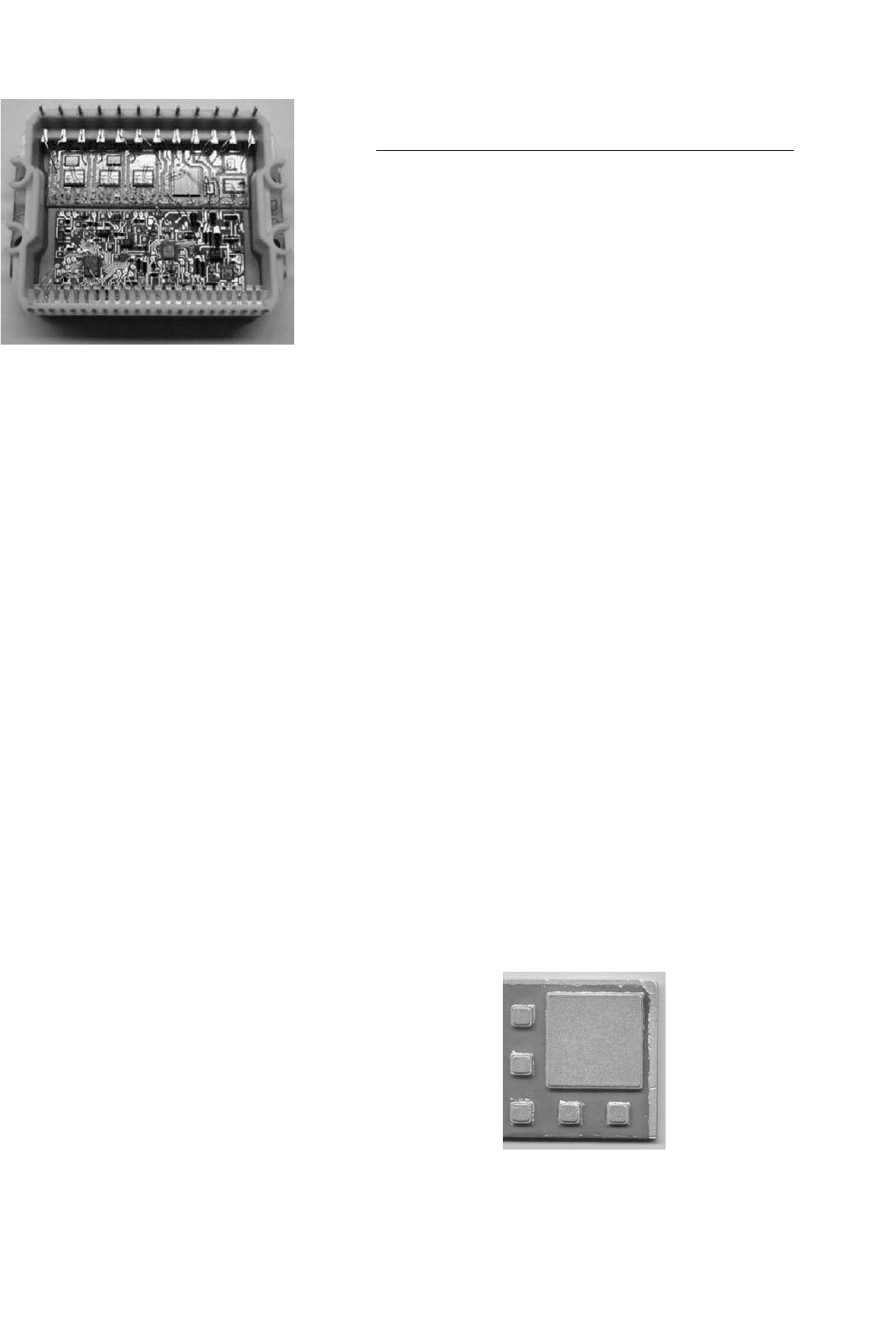
42 Packaging and Smart Power Systems 1157
FIGURE 42.10 Final module combining several packaging approaches.
does not allow component integration at the cost indicated in
Fig. 42.9. A two-substrate solution was needed.
The power DBC was chosen as the obvious highest per-
forming technology among the comparable low cost power
substrates. The DBC is soldered onto a low cost copper base
for thermal management and extends to form a mounting base
for the control substrate.
Multilayer thick film was chosen for control circuitry despite
the apparently high substrate cost. In the motor module,
this substrate is the optimum cost choice because of the
high component integration, such as the three buried power
current-sense resistors and many printed resistors for accurate
active trimming of functions associated with the integrated
circuits. Partitioning cost is minimized by combining intercon-
nections of substrates with interconnection to I/O terminals in
one technology – heavy wire bonding. This has been possible
by designing a MID interconnection component with termi-
nals that are wire bondable on one end and solderable on the
other. The resulting module is shown in Fig. 42.10.
Other components, both SMT and leaded, not best accom-
modated in the module. Therefore, a two layer FR-4 is chosen
as the lowest cost technology suitable for both Delivery Forms
and used for the module and components. Mechanical stabil-
ity and cooling is achieved by using a patented structure of
extruded aluminum profiles.
Using bare die, higher cost substrates and partitioning with
different technologies allows the product to surpass cost tar-
gets. The partitioning in packaging Levels 1 and 2 address
optimization of product business cost as defined in Section 42.5.
Designing the module building block as a component for
reuse across other products increases volume and reduces
cost. More importantly, relative low-volume products can ben-
efit from the building block by faster development cycles,
lower development cost, lower Level-3 packaging cost, and
lower maintenance cost. The building block value addresses
optimization of company business cost.
42.8 High Temperature (HT)
Packaging [6]
Enabling issues for many power electronics applications are
size, weight, and efficiency. Silicon carbide (SiC) semiconduc-
tor technology has the potential to provide up to a 5-fold
reduction in converter volume if the high-temperature, high-
frequency power electronics can be implemented. Higher
frequency operation reduces the size of the passive com-
ponents and, thus, the system volume. Higher operating
temperatures allow a larger temperature difference between
the heat sink and cooling fluid, which increases radiator effec-
tiveness and decreases size. Silicon devices are limited to 150
◦
C
junction temperature prior to de-rating; whereas SiC devices
can operate in excess of 400
◦
C. In addition, SiC devices offer
the potential for incorporating power electronics at point-of-
load (POL), e.g. at the motor or actuator housing, thus greatly
reducing system cabling and volume, and provide increased
flexibility in equipment arrangement. Inherent in all this is the
requirement for very reliable HT electronics packaging.
42.8.1 HT Materials Selection
A paramount requirement of HT packaging is to minimize
dissimilarity in material interfaces and can be achieved with
a “nearly all” Al (aluminum) approach. This includes Al
backed SiC JFETs, AlN substrate, Al
2
O
3
(anodized) electri-
cal insulators, Al interconnects (in place of copper), and
AlSiC (aluminum silicon carbide) heat sinks [7]. Aluminum
is adequately ductile to act as an excellent stress relief during
temperature cycling. Also, Al provides a common metallurgical
bonding medium.
42.8.2 Module Construction
A proposed module structure consists of Al conductors on
AlN substrate on AlSiC. In a one- to two-step casting process,
an Al conductor pattern is formed on AlN, which is captured
into a netshape-cast AlSiC heat sink. A test sample was created
first with multiple pads for JFETs and wirebonds, shown in
Fig. 42.11 (Courtesy of PCC-AFT Inc.). Also, using AlSiC for
FIGURE 42.11 A1/AIN/AISiC casting.

1158 D. C. Hopkins
TABLE 42.3 Material properties
CTE Thermal
conductance
Electrical
resistance
Young’s
modulus
Flexural
Strength
ppm/
◦
C W/m
◦
C mW-cm GPa (MPa)
avg
Al/SiC 8 175 220 369
AlN 4.5 100–180 320 300
SiC 3.7 120–490 550
Al 23 240 4.3
Copper 17 393 1.7
Gold 14.2 297 2.2
Silver 19.7 418 1.6 11
the housing and heat sink allows a ceramic substrate, connec-
tors, and other hardware to be integrated into the mold, or
directly cast into the structure. Connectors that require solder
are nickel and gold plated. Other parts of the module follow
below.
Aluminum Interconnect – Material properties are given in
Table 42.3. Electrical resistance of Al is 2.5 × higher than
Cu and 40% lower in thermal conductance. The performance
reduction is offset with the thicker conductor greatly mit-
igating stresses between the components. Both Al and Cu
approximately double the resistance every 100
◦
C.
Die Attachment – A significant challenge is die attach. The
SiC semiconductor must be bonded to the Al interconnect
with a material electrically conductive, having a high physical
resistance to temperature excursion, and imparting little stress
on substrate or die during power and temperature cycling. One
approach uses a silver–glass composite, which can be cured
and operate at or above 350
◦
C. One material (QMI3555R)
has electrical conductivity of 15 µ-cm and thermal con-
ductivity 80 W/m-K, and is qualified replacement for Si/Au
Eutectic.
Cover Coating and Sealing – If required, an inert HT cover
coating, such as an alumina refractory cement (Cotronics
920), can be used across die and wire bonds. The material
has the properties of alumina ceramic, devoid of outgassing,
completely inert, and good to a service temperature of up
to 1634
◦
C. The coefficient of thermal expansion (CTE) is
4.5 ppm/
◦
C, dielectric strength 270 V/mil, and volume resis-
tivity 1011 W-cm.
Acknowledgment
The author wish to thank Mr. John B. Jacobsen, Technical
Manager, Electronic Engineering and Packaging Department
of Grundfos A/S, Denmark, for supplying most of the
application data used in the module design.
About the Author
Dr. Hopkins received BS and MS degrees from the State
University of New York at Buffalo (UB), and Ph.D. from
Virginia Tech (VPI&SU) where his primary study was in
megahertz-frequency power supplies using high-density pack-
aging techniques. He is an Associate Research Professor,
Director of the Electronic Power and Energy Research Lab-
oratory, Assistant Director of the Electronic Packaging Labo-
ratory at UB, and and IEEE and IMAPS senior member. He
chairs the power electronics packaging technical committees
for IEEE-CPMT, IEEE-PELS, and IMAPS. He has authored
over 50 journal and conference publications. He also has
over 15 years of industrial experience at GEs and Carrier
Air Conditioning Companys’ R&D centers, was visiting fel-
low at several national labs and is president of DCHopkins &
Associates.
Further Reading
1. M. Meinhardt, P. Cheasty, S. Eckert, J. Flannery, S. C. ÓMathúna,
and A. Alderman, “STATPEP-Current Status of Power Electronics
Packaging for Power Supplies - Methodology,” Proc. of the 14th Annual
Applied Power Electronics Conference and Exposition, pp. 16–22, March
14–18, 1999.
2. D. C. Hopkins, S. C. ÓMathúna, A. Alderman, and J. Flannery,
“A Framework for Developing Power Electronics Packaging,” Proc. of
the 14th Annual Applied Power Electronics Conference and Exposition,
pp. 9–15, February 15–19, 1998.
3. R. R. Tummala and E. J. Rymaszewski, Microelectronics Packaging
Handbook, Van Nostrand Reinhold, New York, 1989.
4. “High Voltage Integrated Circuits,” ed. B. J. Baliga, IEEE Press,
New York, IEEE order number: PC0232-9, ISBN 0-87942-242-4,
1988.
5. J. B. Jacobsen and D. C. Hopkins, “Optimally Selecting Packaging
Technologies and Circuit Partitions based on Cost and Performance,”
Applied Power Electronics Conference, New Orleans, LA, February 6–10,
2000.
6. D. C. Hopkins, D. W. Kellerman, R. A. Wunderlich, C. Basaran, and
J. Gomez, “High-Temperature, High-Density Packaging of a 60 kW
Converter for >200
◦
C Embedded Operation,” IEEE Applied Power
Electronics Conference, Dallas, TX, March 19–24, 2006.
7. D. C. Hopkins, J. M. Pitarressi, and J. A. Karker, “Systems Design
Considerations for Using a Direct-Attached-Ceramic MMC Power
Package,” PCIM ’96 EUROPE. Proc. 32nd Int’l Power Conversion Conf.
1996, pp. 683–9 Nurnberg, Germany.

Index
78XX series of voltage regulator, 601
79XX series voltage regulator, 601
ABM techniques, 1122
AC induction motor (ACIM), 683, 865, 1031
AC voltage controllers, 483, 510
AC/AC converters, 483
applications, 510
Active power filter, 749, 1078, 1608
application, 811
concept from, 813
control loop design, 1082
control scheme, 1070
efficiency, 1071, 1080
impact on inverter power, 1089
technical specifications, 1084
types, 1068–1069
Actuators, 335, 642, 644, 652, 843, 845, 902, 1037, 1152
electromagnetic actuators, 642
piezoelectric ultrasonic, 642
Adjustable speed drives (ASDs), 353, 390, 480, 513–515, 839,
1053, 1061, 1067, 1145
advantages, 513
Adjustable speed synchronous condenser, 815
AH capacity, 670
Analog tachogenerator, 865, 904
Anode shorts, 98, 101, 117
ANSI standard, 1054, 1117
Antilock breaking system, 641
Application specific integrated circuits (ASIC), 257
Applications of DC transmission, 773
Artificial intelligence-based controllers, 1015
Artificial neural networks (ANNs), 639, 1015, 1017, 1018
Ann-based controls in power converters, 1029
controls in motor drives, 1025–1029
estimation in induction motor drives, 1017–1025
Asea Brown Boveri (ABB), 236
Automatic circuit recloser (ACR), 1055
Auxiliary inert gases, 568
Axial-airgap/axial-flux machine, 651, 652
Back-to-back diode-clamped converter, 458
Baker’s clamp, 34, 126
Ballast, 197, 546, 556, 565, 567, 570, 586, 641, 1053, 1057
advantages, 571
applications, 589
block diagram, 571
classification, 573
drawbacks, 571
factors affecting design, 572
Base resistance-controlled thyristor (BRT), 127
Basic converter topologies, 522–525
characteristics, 535, 536
correction capabilities, 531–535
Batteries, 4, 451, 453, 589, 621, 630, 656, 670, 671, 677
cadmium, 631
car, 631
charging, 631, 677, 734
comparison among types, 631
lithium-ion, 631
nickel–cadmium, 631
sealed, 677
storage, 669
Bell Telephone Laboratories, 27
Bi-phase half-wave rectifier, 180, 181
Bipolar drive circuits, 912
Bipolar junction transistor (BJT), 10, 27, 41, 71, 138,
544, 897
applications, 37
base–emitter junction, 2–4, 6, 8, 9
collector–base junction, 4
Darlington connection, 30
operation, 28
spice simulation, 36
structure, 28
Bipolar mode operation of SIT (BSIT), 136
Blade pitch control, 674, 707, 708, 739
Blanking time, 255
BLDC motor, 841, 933, 1005, 1012, 1037, 1041, 1044
control topology, 1039
Bonneville power administration (BPA), 793
1159
